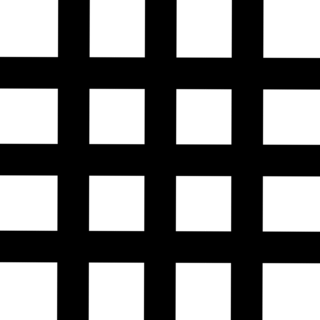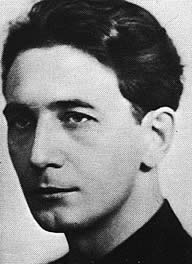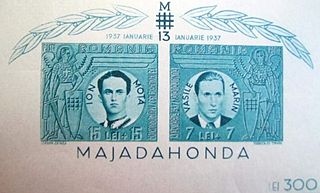
The Iron Guard was a Romanian militant revolutionary fascist movement and political party founded in 1927 by Corneliu Zelea Codreanu as the Legion of the Archangel Michael or the Legionary Movement. It was strongly anti-democratic, anti-capitalist, anti-communist, and anti-Semitic. It differed from other European right-wing movements of the period due to its spiritual basis, as the Iron Guard was deeply imbued with Romanian Orthodox Christian mysticism.

Corneliu Zelea Codreanu, born Corneliu Codreanu according to his birth certificate, was a Romanian politician of the far right, the founder and charismatic leader of the Iron Guard or The Legion of the Archangel Michael, an ultranationalist and violently antisemitic organization active throughout most of the interwar period. Generally seen as the main variety of local fascism, and noted for its mystical and Romanian Orthodox-inspired revolutionary message, Iron Guard gained prominence on the Romanian political stage, coming into conflict with the political establishment and the democratic forces, and often resorting to terrorism. The Legionnaires traditionally referred to Codreanu as Căpitanul, and he held absolute authority over the organization until his death.

Armand Călinescu was a Romanian economist and politician, who served as 39th Prime Minister from March 1939 until his assassination six months later. He was a staunch opponent of the fascist Iron Guard and may have been the real power behind the throne during the dictatorship of King Carol II. He survived several assassination attempts but was finally killed by members of the Iron Guard with German assistance.

Horia Sima was a Romanian fascist politician, best known as the second and last leader of the fascist paramilitary movement known as the Iron Guard. Sima was also the Vice President of the Council of Ministers and de facto co-leader in Ion Antonescu's National Legionary State. Sima had previously served briefly as State Secretary of Education under Gheorghe Tătărescu in 1940, and as a short-lived Minister of Religion and Arts in the government of Ion Gigurtu.

Ion Mihalache was a Romanian agrarian politician, the founder and leader of the Peasants' Party (PȚ) and a main figure of its successor, the National Peasants' Party (PNȚ).

Noua Dreaptă is an ultranationalist, far-right organization in Romania and Moldova, founded in 2000. The party claims to be the successor to the far-right Iron Guard, with its aesthetics and ideology being directly influenced by the fascist movement and its leader, Corneliu Zelea Codreanu.

The Romanian anti-communist resistance movement was active from the late 1940s to the mid-1950s, with isolated individual fighters remaining at large until the early 1960s. Armed resistance was the first and most structured form of resistance against the communist regime, which in turn regarded the fighters as "bandits". It was not until the overthrow of Nicolae Ceaușescu in late 1989 that details about what was called "anti-communist armed resistance" were made public. It was only then that the public learned about the several small armed groups, which sometimes termed themselves "hajduks", that had taken refuge in the Carpathian Mountains, where some hid for ten years from authorities. The last fighter was eliminated in the mountains of Banat in 1962. The Romanian resistance was one of the longest lasting armed movements in the former Eastern Bloc.

Corpul Muncitoresc Legionar or Corpul Muncitorilor Legionari was a fascist association of workers in Romania, created inside the Iron Guard and having a rigid hierarchical structure. From its creation until September 1940, the CML was led by Gheorghe Clime; afterwards, the position was filled by Dumitru Groza, who oversaw the Corps during the period when the Iron Guard was in power — the National Legionary State —, and involved it in the 1941 Rebellion and Pogrom. The CML had its headquarters in Bucharest, on Calea Călăraşilor.

The Funerals of Ion Moța and Vasile Marin were a series of wide-scale demonstrations in Romania. The two leaders of the Iron Guard had been killed in battle on the same day, January 13, 1937, at Majadahonda while fighting on the side of Francoist Spain during the Spanish Civil War, and the funeral that followed took the form of a highly-organized, cross-country procession.
Arise Gheorghe, Arise Ioan! is a poem by Radu Gyr. In 1958 Radu Gyr was imprisoned and sentenced to death by the communist authorities of the Romanian People's Republic because of his subversive poem. The poem had asked for peasants to oppose in every way the regime's agricultural policies: it had been issued as the last wave of brutal collectivization was taking hold of the rural landscape. According to Orthodox priest Fabian Seiche, while in prison, Gyr was not treated for any illnesses he had, was often starved, and even tortured.

The relationship between the Romanian Orthodox Church and the Iron Guard was one of ambivalence. The Romanian Orthodox Church promoted its own version of nationalism which highlighted the role of Orthodoxy in preserving the Romanian identity. Starting with the 1920s, the Church became entangled with fascist politics and antisemitism. In this context, the Iron Guard, also known as the Legion of the Archangel Michael, a fascist movement founded in 1927, became very influential with church grassroots. Numerous rank-and-file priests joined the Iron Guard ranks and actively supported its policies; so did a minority of influential high-ranking clergymen such as Nicolae Bălan or Vartolomeu Stănescu.

The Everything for the Country Party was a political party founded in Romania in 1993 by former members of the fascist Iron Guard and existed until it was banned in 2015. The party claimed to adhere to a "national-Christian" doctrine and styled itself as the successor to the interwar party of the same name.
Vasile Noveanu (1904–1992) was a Romanian activist of the Iron Guard.

The Alliance for the Union of Romanians is a right-wing populist and nationalist political party currently active in Romania and Moldova. It was founded on 19 September 2019 ahead of the 2020 Romanian local and legislative elections. The party president is George Simion.

It has been proposed that Romania withdraw from the European Union (EU), this sometimes being known as Roexit or Romexit.

Ilie Gârneață was a lawyer and founding member of the Legionary Movement, a far-right movement in Romania.

Gheorghe Clime was a Romanian fascist politician, leading member of the Iron Guard, and president of its electoral wing, Totul pentru Țară.

Radu Mironovici was a founding member of the Legionary Movement, a far-right movement in Romania.

Buna Vestire was a far-right Romanian newspaper affiliated with, and later published by, the Iron Guard.
Ernest Bernea was a Romanian sociologist, ethnographer, photographer, philosopher, poet, and far-right ideologue.
















